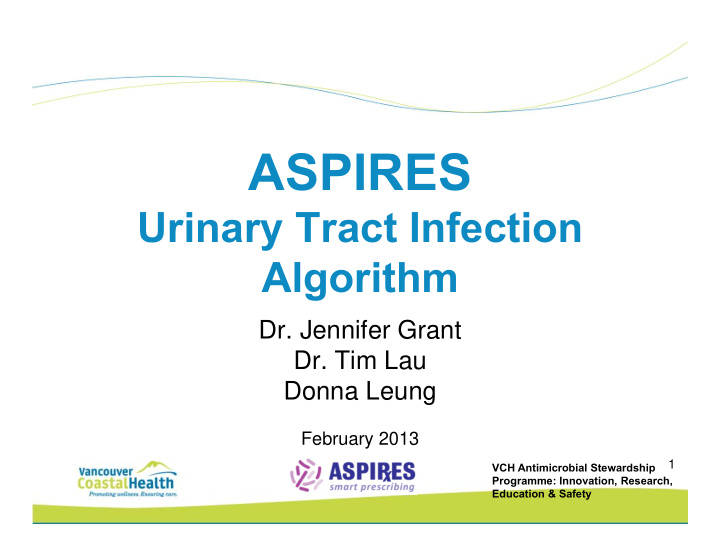



ASPIRES Urinary Tract Infection Algorithm Dr. Jennifer Grant Dr. Tim Lau Donna Leung February 2013 1 VCH Antimicrobial Stewardship Programme: Innovation, Research, Education & Safety
KEY PRINCIPLES Culture only if SYMPTOMS of UTI are present 1. Changes in cognitive function REQUIRES 2. clinical assessment Collect urine for UA and culture 3. – Provides critical information for interpretation 4. Collect urine culture without CONTAMINATION – Clean catch *OR* – In and out *OR* – Change and collect through new catheter Treat patients with SYMPTOMS , not cultures 5. 2
UTI – Elderly population are at increased risk of UTI due to increased post-void residual volume, prostatic hypertrophy, and chronic diseases (e.g., diabetes) 1 – Prevalence of bacteriuria may be as high as 50% in institutionalized elderly patients 2 – Asymptomatic bacteriuria is common in the elderly and does not require antibiotic treatment 1. Foxman B. Epidemiology of urinary tract infections: incidence, morbidity, and economic costs. Disease-a-month : DM. 2003;49(2):53-70. 2. Nicolle LE, Bradley S, Colgan R, Rice JC, Schaeffer A, Hooton TM. Infectious Diseases Society of America guidelines for the diagnosis and treatment of asymptomatic bacteriuria in adults. Clinical infectious diseases : an official publication of the Infectious Diseases Society of America. 2005;40(5):643-54. 3
UTI VS. ASYMPTOMATIC BACTERIURIA (ABU) • Both UTI and ABU result in isolation of significant quantities of bacteria in urine • KEY DIFFERENCE is that UTI involves presence of systemic or local genitourinary signs or symptoms • ABU does NOT require antibiotic treatment • No benefit to treatment of ABU; instead, may cause increased toxicity risk and antibiotic resistance 4
5 UTI MANAGEMENT ALGORITHM
OVERVIEW OF UTI MANAGEMENT ALGORITHM Initiate algorithm only when patient meets diagnostic 1. criteria If catheter is present, remove/replace before urine 2. collection Obtain urine for BOTH UA and UC 3. 4. Based on algorithm, determine whether patient has cystitis or pyelonephritis 5. Initiate empiric therapy accordingly with preferred agents or other agents (when deemed appropriate) – If symptoms are mild, consider waiting for culture results 6
SYMPTOMS OF UTI UTI symptoms Not UTI symptoms • ACUTE DYSURIA and one of • Smelly urine the following in febrile or two • Cloudy urine of the following in afebrile • Confusion without other signs patients: of infection – New or increased urgency • Vaginal discharge – New or increased incontinence – New or increased frequency – New or increased retention – Gross hematuria – Suprapubic pain – Costovertebral pain – Swelling of testes, epididymis, or prostate 7
HOW TO COLLECT A GOOD URINE SAMPLE Clean catch Catheter • Client must be ABLE to • Must be collected collect urine alone or with through a NEW catheter help • In and out if client • Clean perineum or prepuce cannot perform a clean • Let first few drops go catch • Collect sample • Replace existing Foley • Do not allow urine to catheter with a new one contact perineum or to collect sample foreskin (cannot obtain specimen while using bedpan) 8
HOW TO INTERPRET UA & URINE CULTURE RESULTS • Pyuria accompanying ABU is not indication for ABX treatment up to 90% elderly patients may have pyuria 2 • UTI is very unlikely if LE and NIT in UA are both negative (less than 20% chance of UTI) 3 • UC is considered positive when one (predominant) bacterial strain is isolated ≥ 100 million CFU/L • If more than one bacterial strain is isolated or if bacteria count is < 100 million CFU/L, re-culture urine ONLY if patient is symptomatic 3. Ouslander, J. G., M. Schapira, et al. (1995). "Accuracy of rapid urine screening tests among incontinent nursing home residents with asymptomatic bacteriuria." J Am Geriatr Soc 43(7): 772-775. 9
WHEN TO TREAT A POSITIVE URINE CULTURE • If patient has ongoing SYMPTOMS of UTI • Prior to UROLOGIC surgery • Patient shows signs of SEPSIS with no other identifiable source of infection Many patients over the age of 50 years have positive urine cultures. Most don’t have a UTI and don’t need treatment. 10
WHICH ANTIBIOTIC TO SELECT FOR UTI • Nitrofurantoin and TMP-SMX are preferred agents for UTI treatment • Recent antibiogram generated at hospitalist wards suggests E.coli susceptibilities of 95% and 70% respectively • Fluoroquinolones are NOT recommended due to high propensity for collateral damage and resistance (antibiogram suggests only 60% susceptibility) 11
WHEN TO REASSESS UTI THERAPY • Patients generally should start feeling better within 36 hrs of initiating treatment 4 • Continue preferred agents or tailor-down to preferred agents if appropriate once UC results are back (48 hrs) • If on IV therapy, consider step-down to PO if patient temperature <38°C X 24 hrs • Reassess after 2-3 days to ensure clinical improvement; if no improvement, search for underlying cause 4. Colgan R, Williams M. Diagnosis and treatment of acute uncomplicated cystitis. American family physician. 2011;84(7):771-6. 12
QUESTIONS? Antimicrobial Stewardship Programme: Innovation, Research, Education, and Safety Dr. Jennifer Grant – ASPIRES Medical Director (Jennifer.Grant@vch.ca; local 69503) Dr. Tim Lau – ASPIRES Pharmacist (Tim.Lau@vch.ca; local 63361) 13
Recommend
More recommend